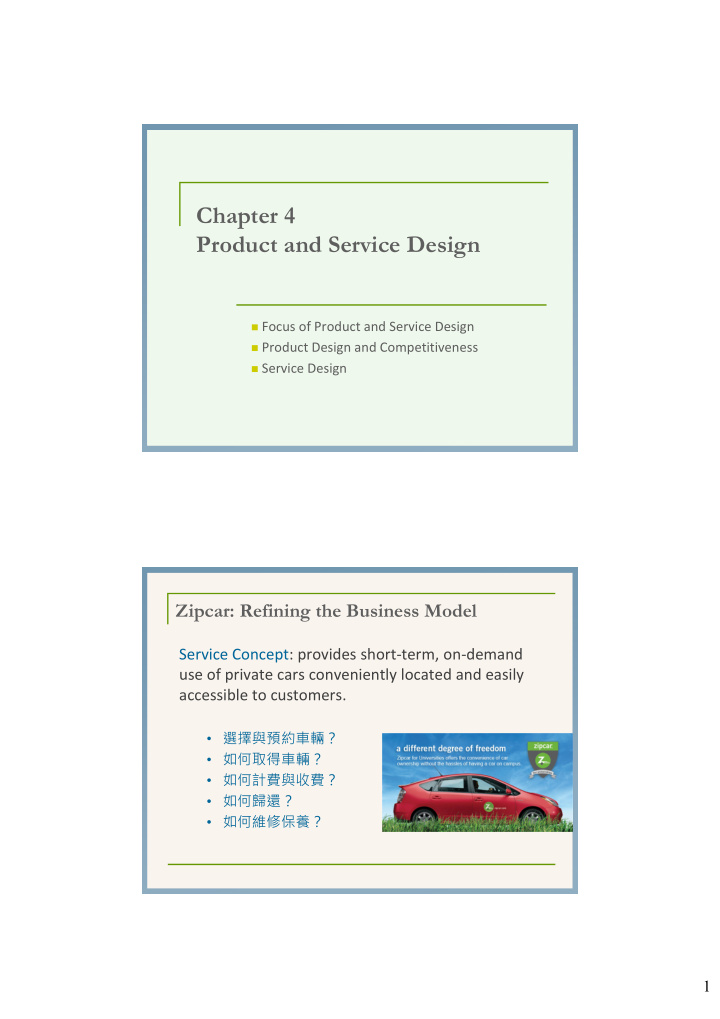



Chapter 4 Product and Service Design Focus of Product and Service Design Product Design and Competitiveness Service Design Zipcar: Refining the Business Model Service Concept: provides short‐term, on‐demand use of private cars conveniently located and easily accessible to customers. • 選擇與預約車輛? • 如何取得車輛? • 如何計費與收費? • 如何歸還? • 如何維修保養? 1
What Does Product or Service Design Do? The essence of a business organization is the products and services it offers, … around those products and services. 1. Translate customer wants and needs into requirements 規格化 Refine existing products Develop new products and services 改善現有 and services 全新設計 Formulate quality goals 品質 Formulate cost targets 成本 6. Construct and test prototypes 試驗 食譜:能做出相同的料理 7. Document specifications 8. Translate into process specifications. 3 Key Questions Marketing? R&D? 1. Is there demand for it? Production? Purchasing? 2. Can we do it? Finance? 3. What level of quality is appropriate? 4. Does it make sense from an economic standpoint? Product and service design—or redesign—should be closely tied to an organization’s strategy 產品代表競爭力 4 2
Idea Generation 點子哪裡來? Research and Development R&D Basic Research Applied Research Development 服務業缺乏專利保護 Reverse Engineering 逆向工程 Dismantling and inspecting a competitor’s product to learn and to discover possible improvements. Original Design Manufacturer ODM 設計代工 5 Product Standardization 單一標準規格? Advantages: Fewer parts to deal with in inventory and manufacturing Reduced training costs and time Quality is more consistent Opportunities for long production runs and automation Disadvantages Decreased variety results in less consumer appeal High cost of design changes increases resistance to improvements 6 3
Mass Customization: A strategy of producing standardized goods or services, but incorporating some degree of customization. 半自助旅遊 Delayed differentiation The process of producing, but not quite completing, a product or service until customer preferences are known. 7 Modular Design (Design For Assembly) A form of standardization in which component parts are grouped into modules that are easily replaced or interchanged. Using multiple‐use platforms 8 4
Design for Production 將好的設計製造出來 First to market Concurrent Engineering 同步工程 bringing engineering design and manufacturing personnel together early in the design phase. Quality Function Deployment 品質機能展開 integrate the voice of the customers into product development. 9 10 5
The Kano Model 狩野紀昭 order winner order qualifier 11 Value Analysis/Value Engineering Examination of the function of parts and materials to reduce costs of order qualifiers and order winners Is the item necessary? Could another material be used instead? Can specifications be less stringent? Can two or more parts be combined? Can packaging be improved to save cost? 採購運用VA以降低採購成本 研發運用VE以避免增加製造成本 12 6
Design for Logistics 13 Legal and Environmental Factors Product liability: the responsibility of a manufacturer for any injuries or damages caused by a faulty product. The Three Rs Reduce: reduce waste, reduce cost Reuse: refurbishing used products Recycle: recovering materials for future use. 14 7
Design a Service is Different Tangible and intangible 無形性 Customer Involvement – created and delivered at the same time 同時性 Services cannot be inventoried 易滅性 Services highly visible to customers (front office) Services have low barrier to entry (competition) Location is important to service design Range of service systems 異質性 Demand variability 15 Designing a Service Package Supporting facility: physical resources that must be in place before a service can be sold 建築外觀、內部裝潢 Facilitating goods: material consumed by the service process 餐盤、食材、商品 Information: operations data or information to enable efficient and customized service 庫存紀錄、教材 Explicit services: benefits readily observable 停車場、網頁 Implicit services: psychological benefits which the consumer may sense only vaguely 服務效率與態度 16 8
location, interior design Customer Supporting Facility Participation service blueprint, Facilitating Goods service recovery Simultaneity Information revenue Perishability management Explicit Services Intangibility Implicit Services service encounter Heterogeneity capacity planning, waiting line management Shouldice Hospital: Hernia Repair 18 9
A Service Blueprint for a Restaurant 顧客到達 顧客離開 用餐 Interactive F Line 前場 訂位 入座點菜 上菜 結帳 Line of Visibility F F 通知廚房 烹飪 準備帳單 後場 Line of Support 準備材料 Fail‐safing = pokayokes service encounter moments of truth 19 標準化服務? Standardizing or reducing consumer choices makes service more efficient, but it can be both frustrating and irritating for the customer. 自動化或自助服務? Automation or reducing customer contact can reduce the cost of providing a service, but it risks eliminating features that some customers value, such as personal attention. 兼職人員? Hiring part‐time or temporary staff reduces cost and increases capacity flexibility, but the use of less‐skilled or less‐interested people may hurt service quality. 20 10
Degree of Complexity/Divergence No Take Table Reservation Reservation Selection Seat guests Self-seating Seat guests Recite menu Fills out Take orders Take orders order Personal service Serve Separate-course Call number service dinner sets 21 Customer as Co‐Producer having customers taking a greater role enhances the service Self service cost, speed, convenience, customization 24 7 service availability Appointments and reservations Customers generated content Wiki, e‐markets 22 11
Technology-Driven Service Innovations Source of Service Example Service Industry Impact Technology Jet aircraft International flight is feasible Power/energy Electric vehicles 電動車 Battery charging/exchange Facility design Hotel atrium Feeling of grandeur/spaciousness Enclosed stadium 開閉頂 Year‐around use Materials Digital camera Photo printing/Tourism Synthetic engine oil Fewer oil changes Just‐in‐time (JIT) Reduce supply‐chain inventories Methods Da Vinci surgery 達文西 Surgeons & quality improvement Information e‐commerce Increase market to world‐wide Internet Video on demand 23 Conclusion 產品的設計直接決定 企業競爭力 產品設計要面對顧客需求、 市場競爭、技術演進 成功的產品設計考慮到對製造與儲運 的影響,以及對環境的影響 無形內容與顧客在場影響服務業的產品設計 服務業的員工招募與訓練須符合產品設計 24 12
Recommend
More recommend